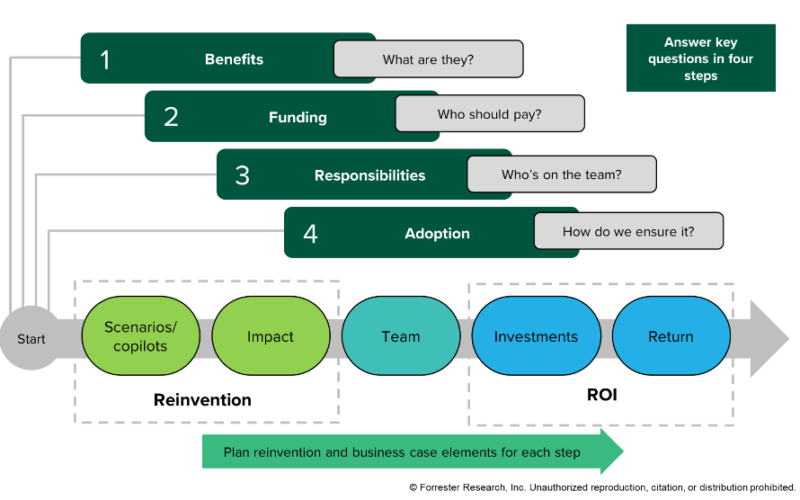AI copilots of all kinds — new off-the-shelf solutions, custom-built applications, or those embedded in business applications — are taking off. But there’s little measurable business return yet, and much confusion. In a new report for Forrester clients, J.P. Gownder and I cut through the vendor clutter with a definition and framework for action to maximize the business value of AI copilots.
Organizations are rapidly adopting AI copilots to drive employee productivity — Forrester’s 2024 data shows that 51% of global information workers say their organization is adopting Microsoft Copilot for Microsoft 365, and the same percentage are adopting ChatGPT Enterprise. In fact, organizations have already deployed tens of thousands of seats of each solution. But so far, leaders tell us, there’s something missing: They seek a clear payoff, and they tell us that they want to know the true return on their investment in AI copilots in the form of a hard-nosed business case.
It’s Time To Take A Pragmatic Approach To AI Copilots Of All Kinds
Calculating the benefits of developing copilots isn’t straightforward, and companies complain that they aren’t able to quantify ROI today, so leaders end up in a conundrum: Do they take a leap of faith that generative AI (genAI) will eventually yield results — jettisoning the business case altogether — or do they delay investment because it’s hard to quantify the benefits? We believe this is a false choice and instead advocate for a holistic approach that is hard-nosed but realistic. To resolve the genAI business case conundrum and confidently move forward with copilot investments, we need to contend with four key questions (see Figure 1):
- Benefits: What are they, really? Leaders want an ROI. But the immediate payoff of AI copilots (Microsoft’s or anybody’s) starts with a better employee experience. If people don’t use the new tools, they bring zero improvements in productivity. And that means focusing on human factors like employee experience, collaboration, and culture. There is thus a delay and a lot of hard work between launching an AI tool and getting the productivity life as employees incorporate them into their daily work.
- Adoption: Why is it so challenging? Following an “If you build it, they will come” philosophy with technology rarely works out: Employees struggle to master new technologies, diminishing their productivity, and sometimes they reject technologies outright. In a worst-case, they conclude that the effort isn’t worth the reward for them and leave the company. GenAI will be even more likely to trigger this set of maladies — broad swaths of employees too often lack the understanding, skills, and ethical awareness to use genAI successfully.Even genAI decision-makers hold misconceptions: For example, Forrester’s 2024 data shows that 70% of US genAI decision-makers agree that “generative AI tools will always produce the same outputs given the same prompt” — an incorrect statement. It’s possible to solve the adoption problem with human-centered design; proper employee training; and a focus on process change, skills development, and continuous support. Few organizations are doing this well today.
- Funding: Who should pay? It’s an unfortunate coincidence that tech leaders, responsible for administering enterprise license agreements are now assumed to have the budget to pay for AI copilots. It can be millions. Where does that money come from? When something is a corporate priority, it demands corporate funding.We have identified key practices to guide your copilot budget conversations. The funding model varies based on whether a copilot is general-purpose (made available to every knowledge worker, clearly a corporate budget), expert-systems (part of a practitioner workflow, often a departmental or operations budget), or task-specific (a required tool, such as those that contact center agents use, always an operations budget). IT can administer these budgets but can’t be expected to dig deep to cover the new costs.
- Responsibility: Whose job is it to make this work? Just as with mobile apps, it takes a village — a collaborative team — to make AI copilots work, but you need more than the IT + business + operations team of the past. Because AI copilots live in the knowledge realm and not just the process realm where mobile apps and automation dwell, the team must also include domain experts to ensure that genAI models make valid intellectual contributions.Given the complexity of incorporating copilots into everyday work, the team should include data, AI, HR, customer experience (CX) and employee experience (EX), and learning and development leaders. Ultimately, you need to workshop, bringing together this entire village of stakeholders to plan your copilot strategy.
Figure 1 Key Steps To Move AI Copilots From Reinvention To ROI
Source link
lol

